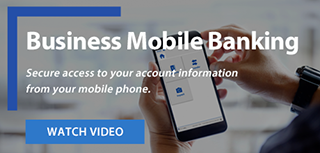We offer a wide array of business banking services so you can focus on what really matters

1,000 free monthly transaction items
1,000 free monthly transaction items
Offers earnings credit on collected balances that may offset or reduce service charges


Corporate Credit Card options for businesses, non-profit organizations or government entities of various sizes are available through our partnership with TCM Bank, N.A. Corporate credit cards can be customized to include the customer’s choice of reward packages and spending limits. All card options include online account access, improved accounts payable efficiency, improved cash flow, and improved reporting to manage and track business expenses. See the card application’s Important Disclosures for current terms, rates and fees. This card is issued by TCM Bank, N.A. Subject to credit approval. Cards are issued by TCM Bank, N.A., and subject to credit approval.
Debit cards can be used to make purchases or to withdraw cash from an ATM. Our debit cards have fraud protection and can be replaced if lost or stolen. The Kirkpatrick Bank business debit card is a powerful tool that offers convenience and control for your business purchases anytime, anywhere.
The internet allows businesses of any size or location to reach new and larger markets. It allows opportunities to work more efficiently using mobile devices or remote access. Whether your business is adopting cloud computing, actively using social media, or just using email and maintaining a website, cybersecurity is critical.
A recent study showed that 87% of small to medium businesses don’t consider themselves a cyberattack target. While larger enterprises may have more data to steal, small/ medium businesses tend to have less secure networks. By using automated attacks, cybercriminals can breach thousands of small businesses at a time, making size less important than security.
There are effective steps any company can take to avoid becoming a victim.
The Federal Communications Commission recommends that all businesses set up a firewall. While external firewalls are somewhat standard, it is recommended that an internal firewall also be set up. Employees working from home should also install a firewall on their home networks, preferably firewall software and support provided by the company.
Business email compromise is an advanced form of spear-fishing and it’s a growing problem and companies are losing thousands, even millions of dollars instantly. Scammers may either gain access to an executive or high-level employee email account or they may spoof the account, changing where the email is sent when the recipient responds. In the first case, the scammer acquires access through a phishing attack and waits for the perfect time to take over, usually when the individual is out of the office for a trip of some kind. The scam targets employees of businesses that regularly perform wire transfer payments or work with foreign companies or suppliers. An email is sent from the CEO or CFO asking that employee to make an immediate or urgent transfer of funds. When receiving any request to wire transfer funds, look closely to verify the email address. Call the person who is supposedly requesting the transfer to verify that they did make the request. If you reply to the message, be sure to look at the real email address before replying. It is best to have a transfer process in place that requires more than just an email request and is a multi-person process.
There are several sources of reliable information and assistance on the topic of business cybersecurity.
Federal Communications Commission
445 12th Street SW
Washington, DC 20580
Phone: 1-888-225-5322
Website:
FCC.GOV
Federal Trade Commission
Business Center
600 Pennsylvania Avenue, NW
Washington, DC 20580
Phone: 1-202-326-2222
Website:
FTC.GOV
(tips & advice, Business Center)
Department of Homeland Security
Offices located in each state
Website: search Cybersecurity | Homeland Security
DHS.GOV
(topic/cybersecurity)
National Cyber Security Alliance
Website:
STAYSAFEONLINE.ORG
(cybersecure-business)
The most important features of our lending practices are a product of our focus on commercial banking and our ability to customize. We know your competitive edge relies on our speed of service and a personalized approach to your needs as much as it does on competitive rates and fees.
Kirkpatrick Bank specializes in real estate lending and can meet all your commercial real estate needs, including:
Kirkpatrick Bank provides flexible and competitive rates and terms on virtually any capital equipment acquisition, including:
A Kirkpatrick Bank line of credit can provide you with available resources to manage the daily financial needs of your business.
As part of our commitment to the growth of small businesses, Kirkpatrick Bank is a leading participant in the lending programs of the U.S. Small Business Administration.
Other business services including alternative financing options, succession planning, and advisory services are also available.
Business Online Banking can be tailored to meet your specific needs.
A Business Banking Representative will work with the business to customize user access and user privileges.
• Benefits of Business Online Banking include:
• Real-time balance information and pending transactions
• Account View and Transfer
• Manage accounts for multiple business entities utilizing one set of login credentials
• Convenient Bill Pay
• Synchronization of your account transactions through Quickbooks
• Multiple permission/security levels available
• Initiate/approve ACH files and transactions
• Initiate/approve domestic wires

Access Internet banking from anywhere, anytime via iPhone, iPad, or an Android mobile device.
Simply download the KBBiz Mobile app. Customer must be enrolled in Business Internet Banking to access this service.
Benefits Include:
• Access to accounts
• Transfer money between accounts at Kirkpatrick Bank
• Deposit checks or view mobile deposit history
• Pay bills, view bill payment history or approve a bill payment
• Originate or Approve an ACH File from existing templates. Customer must enter into an ACH Origination Agreement for this service
• Originate or Approve a domestic wire transfer from existing templates. Customer must enter into a Wire Transfer Agreement for this service.

Allows commercial customers to originate payments to vendors or transfer funds to accounts help at other financial institutions. The payment or transfer of funds is guaranteed to be in the recipient's account by the effective date defined by you.
Benefits Include:
• Recurring payment options
• Increased security
• Lower cost alternative for remitting payments
Direct Deposit of Payroll
Allows commercial customers to originate payroll credits directly to their employee's accounts at any financial institution.
Benefits Include:
• Reduced costs associated with check writing
• Peace of mind for you and your employees
• Environmentally friendly due to reducing your carbon footprint
ACH Collection allows commercial customers with the ability to collect funds from their members or clients at different financial institutions. Options to debit multiple accounts outside from other financial institutions and credit their account at Kirkpatrick Bank for the sum of those debits.
Benefits Include:
• Enhanced cash flow
• Recurring payment options

Through Business Internet Banking commercial customers can simply scan checks with a check scanner and transmit their deposits directly to Kirkpatrick Bank’s data processor. Advantages for Kirkpatrick Bank customers can include:
• 7:00 pm CST / 6:00 pm MST deposit deadline
• Eliminate the need to transport deposits to the bank
• Detailed online reporting of check information and deposit activity.

Positive Pay is a fraud prevention service that enables you to transmit your issued check file to the bank for daily reconcilement of checks being presented for payment. Any items that don't match are shown as an exception item and through Business Online Banking, you make your decision on whether the item should be paid. Positive Pay can save you money by minimizing the risk of fraud and forgery.
• Automated notification of exceptions
• Online exception management and image archive

You can define business rules, using an ACH authorization or a transaction filter/block, at the account level for monitoring ACH activity in an effort to protect your account from fraud. Every ACH transaction that is presented for payment is scrutinized against these rules to determine whether a transaction warrants your further review.
• Automated notification of exceptions
• Online exception management and image archive
Review all previous day checks presented for payment prior to paying them.
• Verify endorsements or lien waivers
• View an image of each item to assist in making your decision to pay or not pay
Convenient and easy option to pay bills online. Initiate bill payments through Business Online Banking or through Business Mobile Banking. Customer must be enrolled in Business Online Banking to access this service.
• Schedule automatic or recurring bills for payment
• Set up reminders for bills due and payments made
• View pending bills, recent bills and bill history
• Add and manage biller categories

• Sole proprietors with a need to process payments from their smartphone or mobile device
• On-the-go businesses needing a handheld, full-function POS in a small footprint with more functionality than a phone (at a low cost)
• Restaurants or general retail needing a feature-rich full point of sale system integrating with orders, assignments and pay at table options
• Any business needing to integrate purchase options on their website
• Any business interested in integrating QuickBooks processing
• Any business interested in accepting PayPal transactions
• Non-profits seeking to increase fundraising capabilities and lower costs
• Municipalities, Counties, agencies, and schools looking for cloud-based solutions for revenue collection
Best news of all – our merchant services systems and programs are fully EMV compliant, and can grow with your business. Start out using a phone and grow to using a full point of sale system? No problem, your back office support is the same, maintaining continuity and security, supporting any system or program. Fast, efficient, reliable.
Process on the go with your smartphone or tablet with fast activation and pairing – Android or Apple; reliable and secure
Handheld, full-function POS in a small footprint, with additional features like save/hold, recall orders, inventory alerts, email and print options, sales reporting/analytics, and more.
All of the above, plus pay at table, optional accessories like kitchen printers, BT scanners, customer-facing touch display for on-screen tipping and signature capture
Online gateway and virtual terminal integrating with your website for payment processing to support shopping carts, recurring transactions, credit card expiration reporting, and more…
This page contains training, information, and tools needed for originating Automated Clearinghouse (ACH) transactions.To better understand how electronic payments can enhance your business, please visit Electronic Payments sponsored by NACHA, The Electronic Payments Association. Whether looking into electronic payments for the first time or having experience originating payments, you will find a wealth of useful information, from sample direct deposit or debit forms to justify the expense of implementing ACH origination. DIRECTDEPOSIT.ORG
To better understand ACH Rules, start by creating a free Basic User account, the NACHA, where you can access the entire ACH Rules data base.
NACHA RULES ONLINE
2025 NACHA QUICK REFERENCE CARDS
Allows commercial customers to initiate payments to vendors or transfer funds to accounts at other financial institutions. Commercial customers can control when the recipient receives funds. As an additional benefit, the payment or transfer of funds is guaranteed to be in the recipient’s account by the effective date defined by our commercial customer
• Recurring Payment Options
• Increased Security
• Lower cost alternative for remitting payments

Allows commercial customers to originate Direct Deposit of Payroll to employee accounts at any financial institution. Business Internet Banking also supports imported NACHA (National Automated Clearing House Association) formatted files from payroll sources such as QuickBooks.
• Reduce costs associated with check writing
• Peace of mind for you and your employees
• Environmentally friendly due reducing your carbon footprint

Allows commercial customers to originate electronic tax payments to federal and state tax authorities through the secure online system.
Commercial customers may securely originate domestic wire transfer requests through Business Internet Banking. Wire requests may be set to recur. Domestic wire requests will be processed Monday through Friday 8:00 am to 4:00 pm CST. International wire requests will be processed Monday through Friday 8:00 am to 2:00 pm CST.
• Token authentication for additional security
• Expedite funds transfers
Convenient and easy option to pay bills online. Initiate bill payments through Business Online Banking or through Business Mobile Banking. Customer must be enrolled in Business Online Banking to access this service.
• Schedule automatic or recurring bills for payment
• Set up reminders for bills due and payments made
• View pending bills, recent bills and bill history
• Add and manage biller categories

Kirkpatrick Bank is not responsible for the product, service, or overall website content available at this third-party site. Our Privacy Policy does not apply to linked websites and you should consult the privacy disclosures on that site for further information.